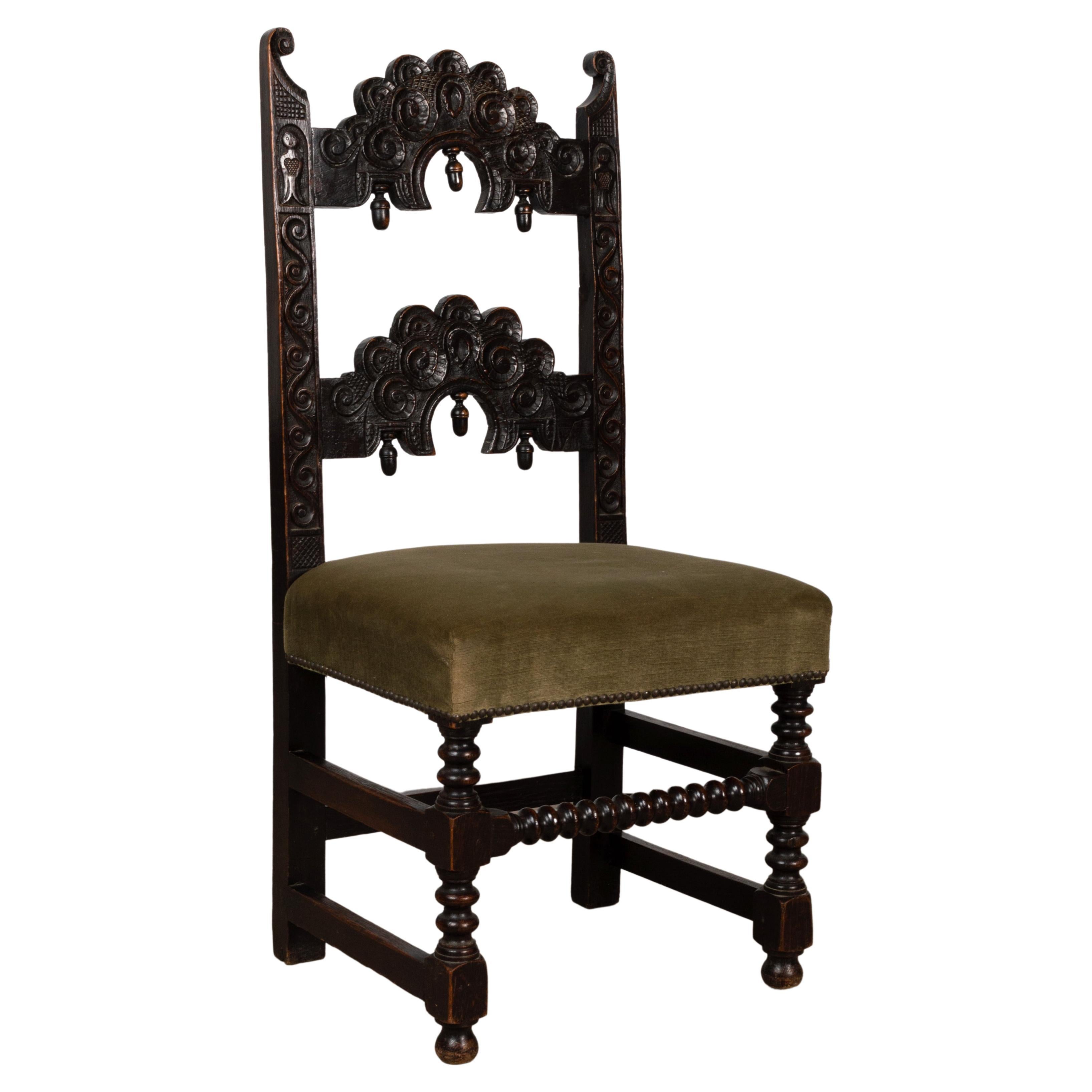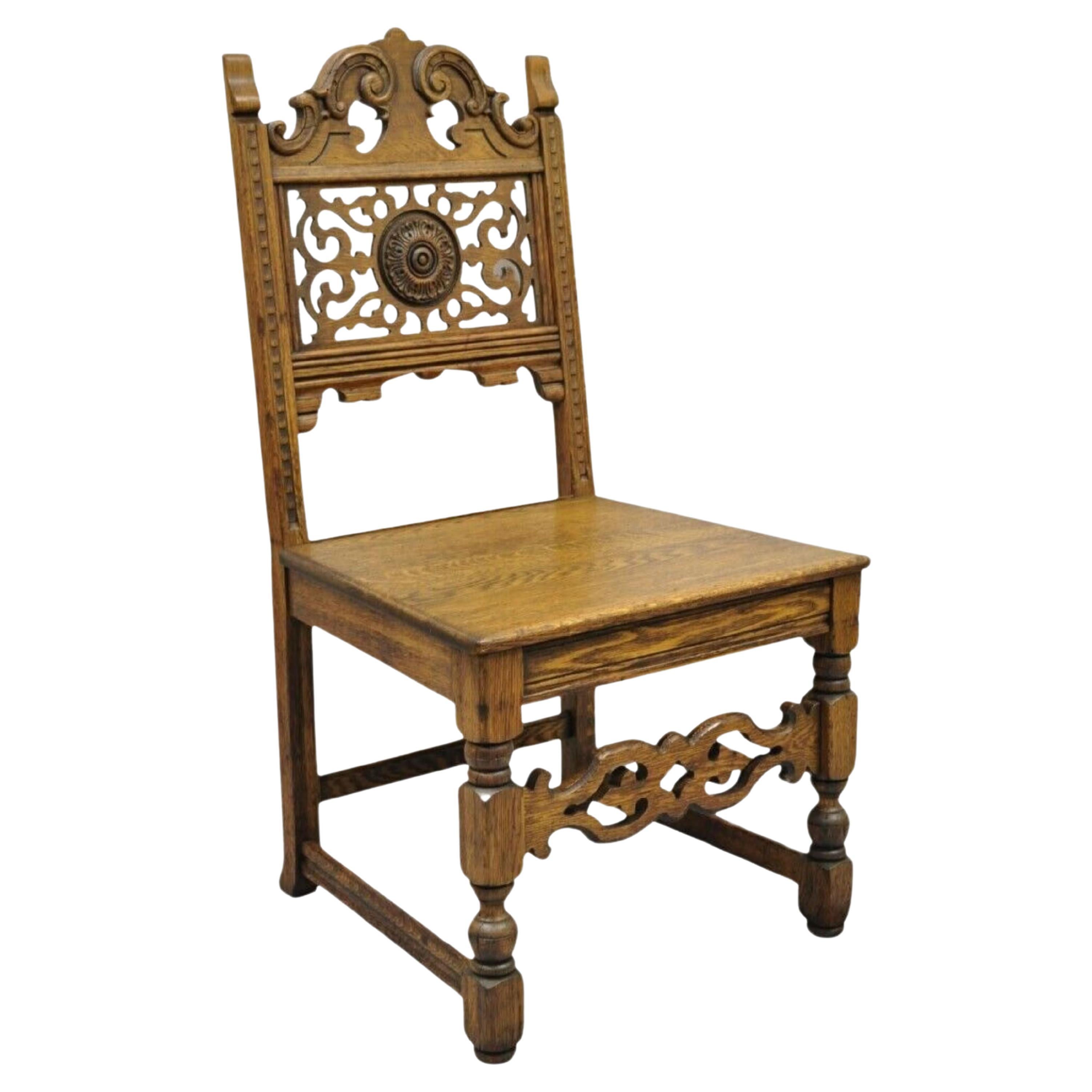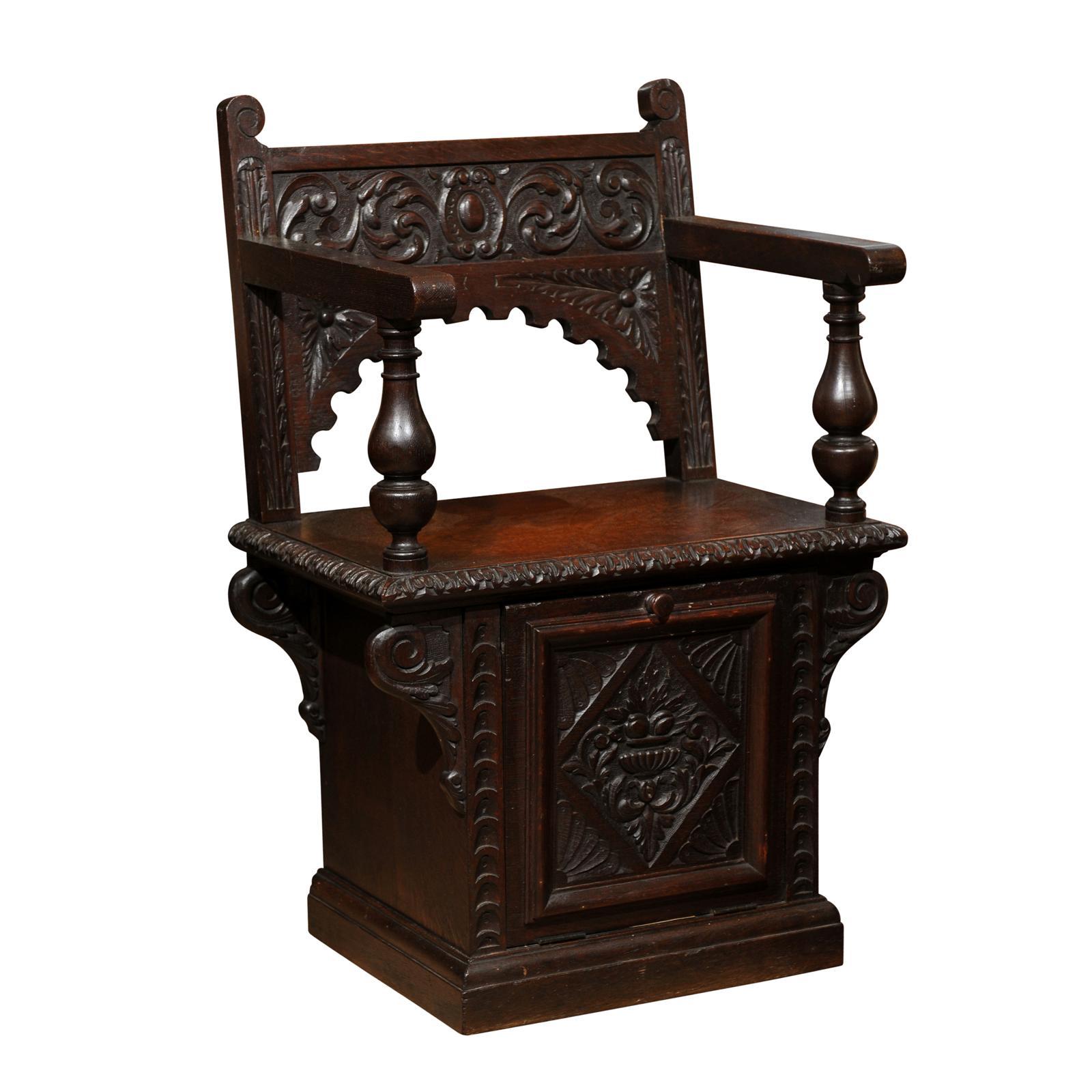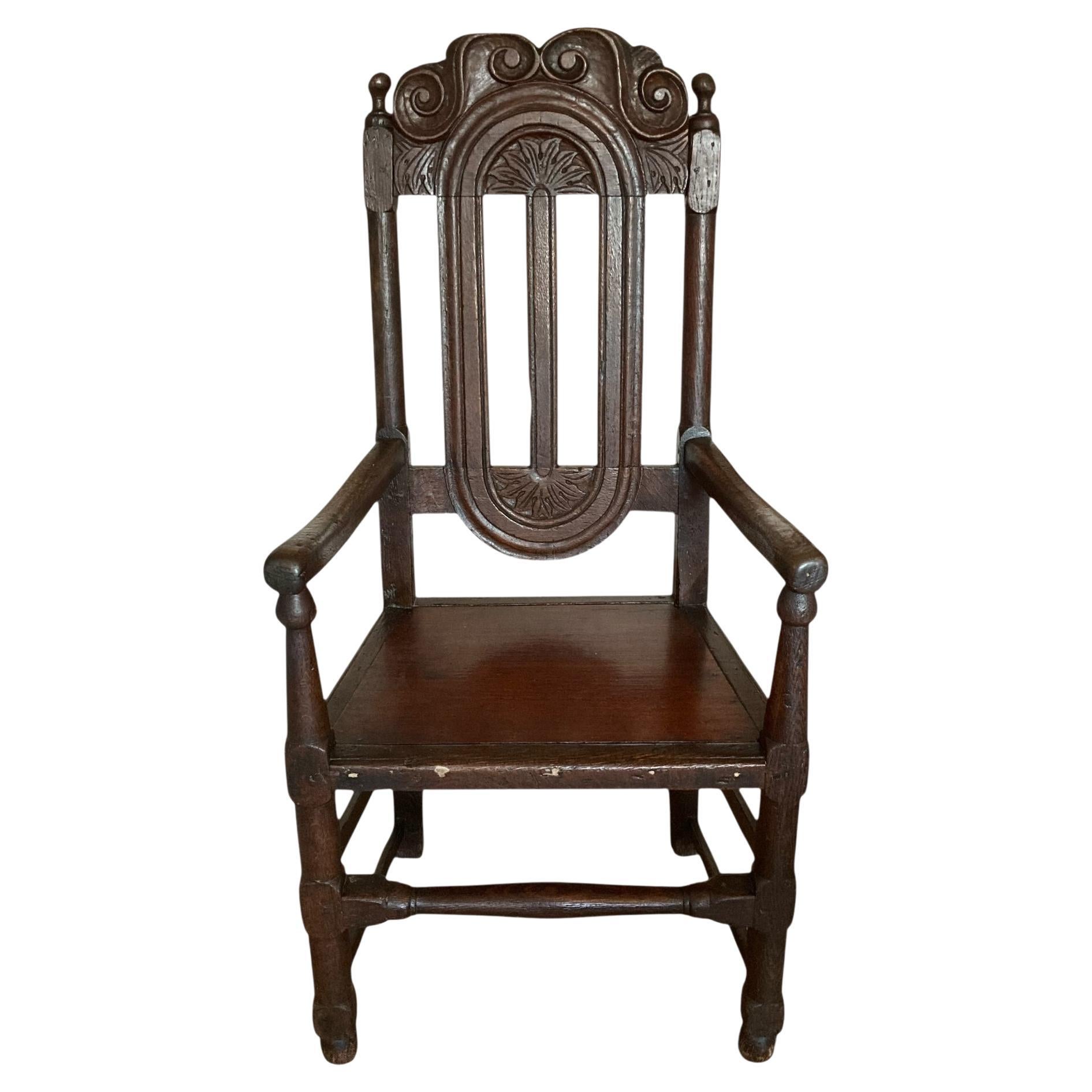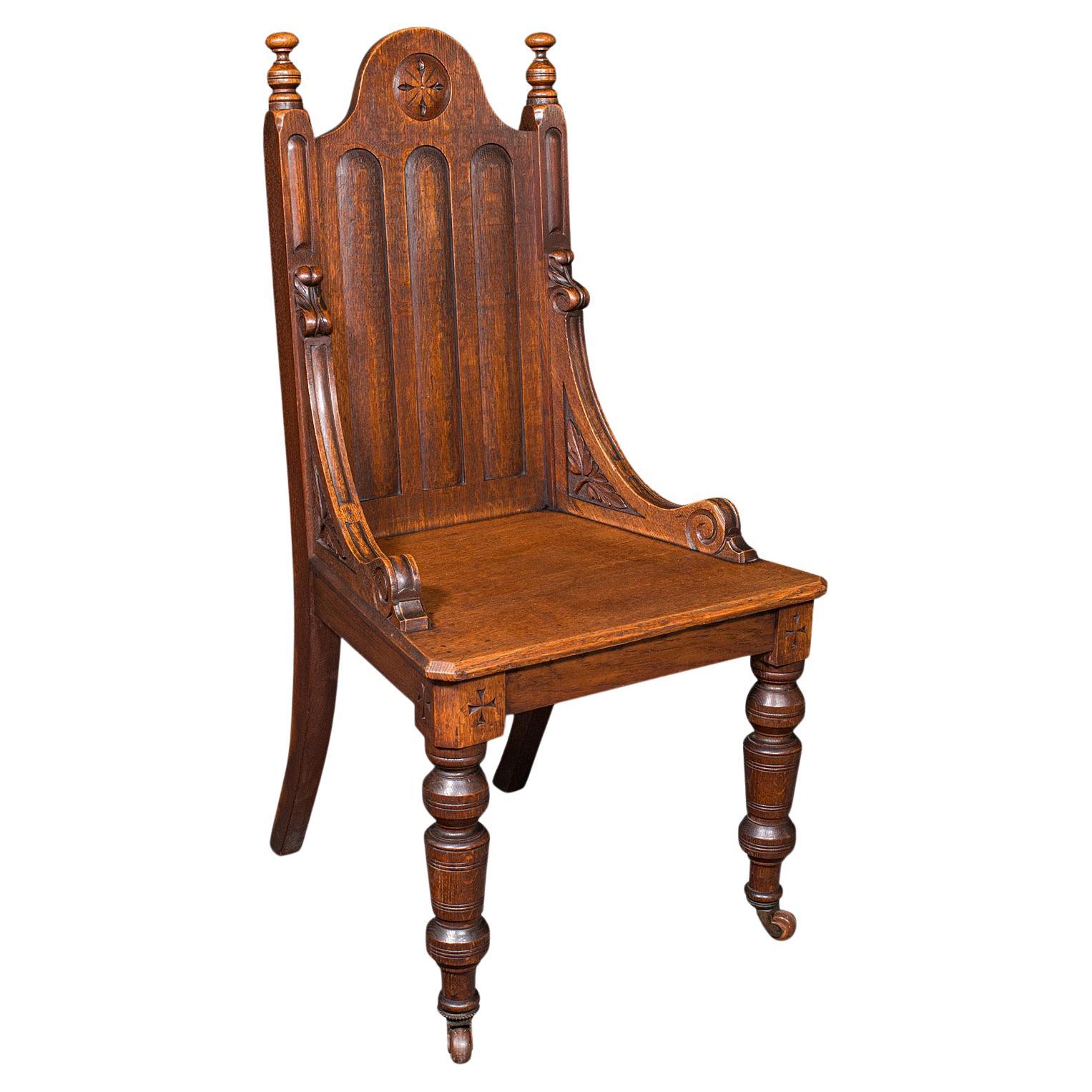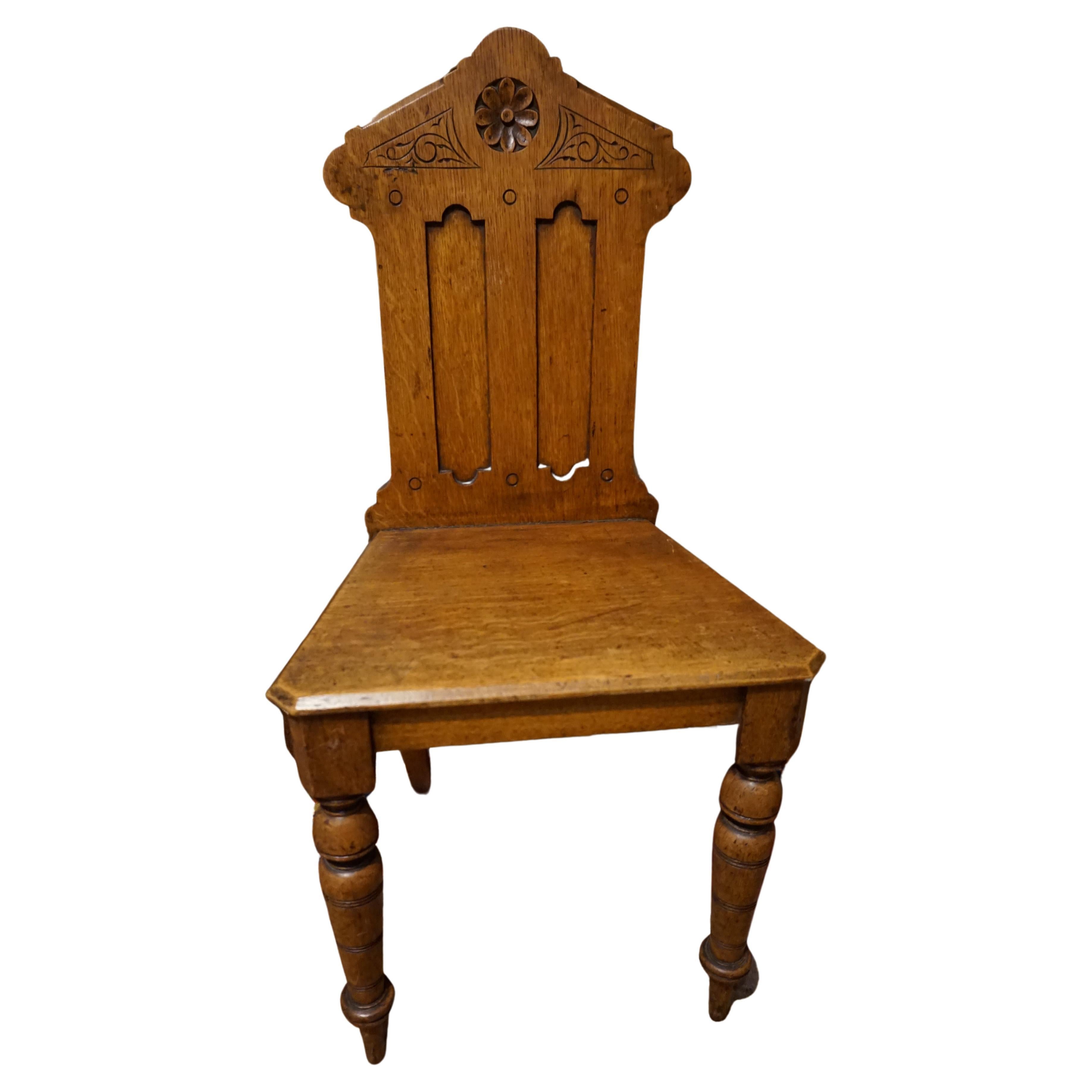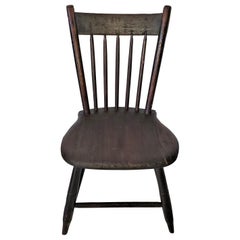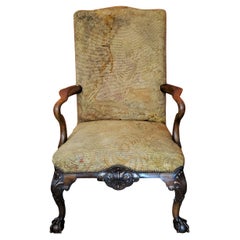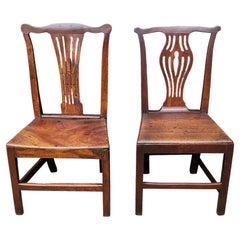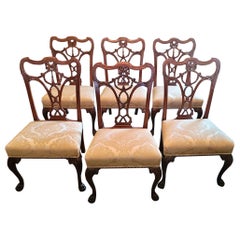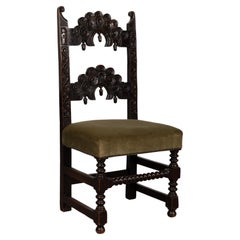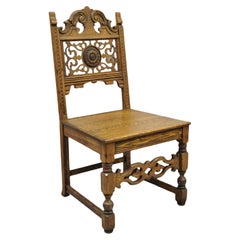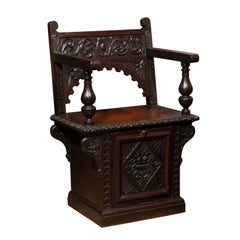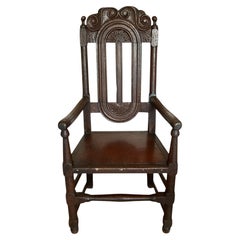Items Similar to 19C English Rococo Revival Ecclesiastical Oak Hall Chair
Want more images or videos?
Request additional images or videos from the seller
1 of 12
19C English Rococo Revival Ecclesiastical Oak Hall Chair
$2,400
£1,819.53
€2,097.44
CA$3,380.01
A$3,748.19
CHF 1,969.39
MX$45,796.47
NOK 24,639.81
SEK 23,128.67
DKK 15,657.78
About the Item
PRESENTING a FABULOUS 19C English Rococo Revival Ecclesiastical Oak Hall Chair.
Made in England (Britain) circa 1870 in the Rococo Revival Style from solid oak.
The large carved acanthus rosette on the crown/pelmet is in the classic rococo style.
The crown is flanked by a pair of pointed and turned finials that top the side pillars. The pillars consist of carved and turned barley twist columns.
The central backing of the chair consists of a large carved and pierced scrolling section, with button decorations and a central armorial style crest featuring a central carved ‘heart’, flanked by attached feathered ‘wings’ and a carved scroll/motto above, with the words “SURSUM” carved into the scroll.
The rear legs are straight but curve outwards.
The seat is almost square in shape, but gets wider towards the front.
Plain horizontal supports on the back and sides below the seat but paneled on the front.
The front 2 legs are, again, barley twist with turned and pointed feet.
Plain on the back, which clearly tells us that this was made as a ‘Hall Chair”.
“SURSUM” is Latin for ‘UPWARDS’ and coupled with the winged heart, the message for this chair is clear …. “Raise Your Heart Upwards”.
It clearly has an ‘ecclesiastical’ or religious influence and was probably custom made for a religious cleric.
ONE OF A KIND PIECE!
Provenance: From the Private Collection of an Episcopalian Bishop, originally from Canada, with deep roots in Scotland.
Condition: Very good original condition. One crack on seat, but not noticeable and in no way affects the chair’s stability. Some ‘rubbing’ on the seat.
Dimensions: 44 inches tall, 18.5 inches wide at front, 20 inches deep, 15.75 inches seat height. 16 inch seat depth.
- Dimensions:Height: 44 in (111.76 cm)Width: 18.5 in (46.99 cm)Depth: 20 in (50.8 cm)Seat Height: 15.75 in (40.01 cm)
- Style:Rococo Revival (Of the Period)
- Materials and Techniques:
- Place of Origin:
- Period:
- Date of Manufacture:1870
- Condition:Wear consistent with age and use. Minor structural damages. Minor fading.
- Seller Location:Dallas, TX
- Reference Number:1stDibs: LU3978137806782
About the Seller
4.9
Gold Seller
Premium sellers maintaining a 4.3+ rating and 24-hour response times
Established in 2015
1stDibs seller since 2018
393 sales on 1stDibs
- ShippingRetrieving quote...Shipping from: Dallas, TX
- Return Policy
Authenticity Guarantee
In the unlikely event there’s an issue with an item’s authenticity, contact us within 1 year for a full refund. DetailsMoney-Back Guarantee
If your item is not as described, is damaged in transit, or does not arrive, contact us within 7 days for a full refund. Details24-Hour Cancellation
You have a 24-hour grace period in which to reconsider your purchase, with no questions asked.Vetted Professional Sellers
Our world-class sellers must adhere to strict standards for service and quality, maintaining the integrity of our listings.Price-Match Guarantee
If you find that a seller listed the same item for a lower price elsewhere, we’ll match it.Trusted Global Delivery
Our best-in-class carrier network provides specialized shipping options worldwide, including custom delivery.More From This Seller
View All19th Century American Walnut Childs Chair with Provenance
Located in Dallas, TX
Presenting an absolutely stunning and historic 19th century American walnut childs chair belonging to Lida Calvert Hall 1867.
This Chair has impeccable provenance:
It is part o...
Category
Antique Mid-19th Century American American Craftsman Chairs
Materials
Walnut
18C English Chippendale Shepherds Crook Armchair
Located in Dallas, TX
Presenting an absolutely stunning and original 18C english chippendale shepherds crook armchair.
Made in England circa 1780-1800 of walnut, this ‘period’ chair is simply Gorgeous in it’s Originality!
It is still covered in it’s original needlepoint/tapestry upholstery with neo-classical elements of a Greek or Roman Goddess sitting holding a staff on the back splat and floral motiff’s elsewhere.
What makes this piece Truly Original is the fact that the needlepoint appears to have been signed by the original owner/maker of the tapestry and it appears to be the family name of “Tancret”.
The arm rests have the most glorious ‘shepherd’s crook’ twists and turns.
The central base section has what appears to be heavily carved Prince of Wales Plumes, signifying the Regency Era.
The knees of the 2 front legs have the most amazingly carved acanthus relief decoration and the 2 front legs end in the best example of ball and claw feet you are ever likely to see.
The back legs also have some interesting detail as the feet are platformed or hooved.
Overall, the piece is in great condition for it’s age and use. There are no major tears or holes in the original tapestry. There is some discoloration but that is to be expected with a piece this old.
There is a very small piece of the central front medallion (bottom left as you look) missing, but it is not noticeable and does not detract from the piece.
One small stain on the back.
Gorgeous natural patina to the wood.
Provenance: From a Wealthy Estate in Kentucky/Tennessee
Condition: Very good. See full description.
Dimensions: 44? tall, 28? wide and 27? deep
Seat height of 18.5? with seat depth of 17.5? and interior seat width of 22.5?
Armrests are 26.25? Tall
The vast movement of people that followed the Norman Conquest of England in 1066 brought the Tancret family name to the British Isles. Tancret comes from the ancient Norman given name Tancred. The Tanksley variant is indeed rare. However, this name traces its origin to Roger Tankerlayman who was listed in Yorkshire in 1387.
Because of this political and religious unrest within English society, many people decided to immigrate to the colonies. Families left for Ireland, North America, and Australia in enormous numbers, traveling at high cost in extremely inhospitable conditions. The New World in particular was a desirable destination, but the long voyage caused many to arrive sick and starving. Those who made it, though, were welcomed by opportunities far greater than they had known at home in England. Many of these families went on to make important contributions to the emerging nations of Canada and the United States. Analysis of immigration records indicates that some of the first North American immigrants...
Category
Antique Late 18th Century English Chippendale Armchairs
Materials
Tapestry, Walnut
Pair of British Country Squire's George II Side Chairs
Located in Dallas, TX
Presenting an absolutely gorgeous pair of British Country Squire’s George II Side Chairs.
When we say that we ‘LOVE’ our antiques to be of quality, ...
Category
Antique Mid-18th Century English George II Side Chairs
Materials
Elm, Oak
19C Set of 6 Irish Chippendale Style Ribbon Back Dining Chairs
Located in Dallas, TX
Presenting a fabulous 19C set of 6 Irish Chippendale style ribbon back dining chairs.
Irish made circa 1840-60.
We know that these are Irish due to the signature ‘hairy paw’ feet which is synonymous with Irish Georgian furniture that were made in the Chippendale Style.
These are hand crafted chairs, made of mahogany, and have fabulously detailed ‘Ribbon’ backs splats with tassel, acanthus floral and bow details.
All 6 have been re-upholstered by us in a gorgeous tan/light gold silk damask fabric which is beautifully sympathetic to the style and period.
We are confident that these are Early to Mid 19th Century chairs for a number of reasons: (1) The are hand crafted, (2) the color/patina is what you would expect with natural aging, (3) they have evidence of historic repairs, wear and tear consistent with age, (4) when we removed the old upholstery fabric, which looked like it was done in the 1980’s, we discovered the original ‘horse hair’ cushion filling … this practice stopped in the early 20th Century. The seat webbing was also much older and needed replacing.
Fabulous acanthus carving on the knees of the front legs, with curved legs leading down to the fabulously carved hairy paws.
Nice indented decoration on the front of the seat.
The rear legs are undecorated and curve outwards for additional support and stability.
Unsigned and unmarked but undoubtedly made by a top Irish furniture maker. probably in Dublin.
Condition: Each chair has been newly re-upholstered and seat webbing replaced. The original horse hair cushion filling was cleaned and incorporated into the new cushion with modern foam to create a more comfortable and uniform seat cushion, but still retaining originality.
Each chair has signs of historic repairs to the ribbon back splats over the generations. This is not unusual due to the somewhat delicate nature of these types of back splats. Also, it is an indicator of true age. The chair to the back left in the main photos has had the most repairs and much more recently performed (by us) as the back splaty was broken in 2 places (but we had the original pieces) and the chair needed the insertion of metal pins to secure the repaired sections. We have provided a couple of photos of this back splat which you can see evidence of the repairs.
The repairs are very professionally done and the chair is now fully functionable and usable and the repairs are not very noticeable.
These repairs are reflected in the pricing, as, if these chairs were ‘mint’ they would be very valuable and expensive !
Irish furniture can be recognised by certain features, which differentiate it from its European counterparts. The Irish style of furniture is said to have been lagging behind in fashion compared to English equivalent by a number of years, in both its design and manner by which the furniture was manufactured. A defining feature of the mid-eighteenth-century furniture is the carving on different parts of the furniture such as the aprons, blanket chests, bottle-stands and such objects. The carvings included foliated details, baskets of flowers and scallop shells, which are some of the most prominent carvings that are represented on Irish furniture at this time. A few of the Irish makers of these objects were James Hicks, Arthur Jones, William Moore, Mack & Gibton and Robert Strahan. All though individuals would have been the most prominent at the time of the 18th century and early 19th century but there are any other cabinet makers as well.
Not all Irish furniture was detailed with such wonderful carvings and some might have been seen to be rather plain. One of the most identifiable items that are described as plain is the Irish Hunt Table, its simple elegance comprising of with straight plain legs. It was most commonly used in the dining room of a rural house such as a agents house or large house of a land holder. Another very popular and simply designed piece was the Irish Silver table, its design is very elegant and yet individual partially owing to the shell motive.
Other examples of such Irish tables are side tables which have a distinctive double scrolled leg. Usually legs are carved with acanthus and have paw feet which are quite popular in Ireland but more rare in England. Other features are the inside leg which is carved with elongated C-scroll. The triple scroll on the leg was common place. Some cabinet makers and creativity was really captured with their side tables in how the carving was done. This carving may include Jupiters eagle or Lion mask and flanked Swags of flowers. In other furniture such as chairs, the H-shaped serpentine stretcher was popular in the 18th century in Ireland and when English chairs had moved forward in their design the Irish makers were still using the H-shaped serpentine. There was certainly an overlap between Irish and English furniture, one can see that Irish cabinet makers used English pattern books but used Irish features such as the carvings as the shell, baskets of flowers and foliated details. Another unique feature in Irish cabinet making was Killarney ware...
Category
Antique Mid-19th Century Irish Chippendale Dining Room Chairs
Materials
Mahogany
19th Century Irish Country Squire's Oak Telescopic Dining Table
Located in Dallas, TX
From circa 1860, five beautifully turned baluster legs on brass castors, beautiful oak patina on top with a high gloss finish.
It is very rare to find one of these made of solid oak...
Category
Antique Mid-19th Century Irish High Victorian Dining Room Tables
Materials
Oak
Carved Spanish Oak Writing Cabinet, Estate of Vincente Blasco Ibanez
Located in Dallas, TX
Presenting an absolutely stunning 16th century carved Spanish oak writing desk and cabinet, with amazing provenance and historical and literary significance.
This desk/cabinet was purchased by a wealthy Dallas family from a French antique auction held at the club room in the Stoneleigh court (hotel), Dallas on Wednesday the 2nd April 1930. (Now the meridian hotel). The auction was titled: “works of art and furnishings of the Chateau de Turique (Nancy) and the Conde-Rougemont home (Touraine). The cover of the catalog also has a seal of a coat of arms. The second page gives a brief description of the auction contents and states that " this exhibition will be presented by M. Fernand M. Adda of Paris France". The desk/cabinet was lot no: 565 and was described in the auction catalog as:
"Carved Spanish writing desk and cabinet...... 16th century period....Upper section a cabinet with two doors which are paneled and display a fine carving. The interior is fitted with eight engraved drawers, and a writing tablet is disclosed in the lower portion. Sustained and central arcade of columns. From Fontana Rosa collection. Supported on four turned legs with bulbous feet."
Fontana Rosa is a historic garden situated on the avenue Blasco Ibáñez in Menton, Alpes-Maritimes, on the French Riviera. The Spanish writer Vicente Blasco Ibanez (1869-1928) began to build it from 1922 on, and he set up home here with his second wife, Elena, and died there in 1928. Vicente Blasco Ibanez was a journalist, politician and best-selling Spanish novelist in various genres whose most widespread and lasting fame in the English-speaking world is from Hollywood films adapted from his works. The provenance is impeccable, it belonged to Ibanez and was part of his collection at Fontana Rosa when he died in 1928.
The auction in which it was first sold in Dallas was in 1930, which makes perfect sense from a 'timeline' point of view. Ibanez is a very important literary figure. Having regard to the fact that this is a writing desk means that in all probability, Ibanez would have 'penned' some of his famous works at this very desk and using the surviving slope/shelf.
Fontana Rosa is a historic garden situated on the Avenue Blasco Ibáñez in Menton, Alpes-Maritimes, on the French Riviera.
The Spanish writer Vicente Blasco Ibáñez (1869-1928) began to build it from 1922 on, and he set up home here with his second wife, Elena, and died there in 1928.
This garden with Spanish and Menton pottery is found in avenue Blasco Ibanez, near Garavan station, and was created a Historical Monument in 1990.
It is also called “Le Jardin des Romanciers” (El Jardín de los Novelistas/The Garden of Novelists), and was frequented by celebrities such as Jean Cocteau. It was the place where Blasco Ibáñez wrote Mare Nostrum, a novel filmed later in 1926.
The garden inspired by Andalusian and Arabian-Persian styles contains species such as Ficus macrophylla, Araucaria heterophylla , palm trees, banana trees or scented rosebushes. It is a tribute to Vicente’s favourite writers : Cervantes, Dickens, Shakespeare or Honoré de Balzac, whose busts can be found at the entrance and to whom he dedicated several fountains and rotundas.
Its main buildings are a small elevated villa with polychromatic pottery which houses a library and a personal movie projector...
Category
Antique 16th Century Spanish Renaissance Cabinets
Materials
Oak
$10,000 Sale Price
20% Off
You May Also Like
Antique English 19th Century Charles II Style Oak Hall Chair
Located in London, GB
An antique English 19th century Charles II style Derbyshire oak bar back chair
A Charles II style Derbyshire oak bar back chair,
19th century with ...
Category
Antique 19th Century Charles II Chairs
Materials
Upholstery, Oak
Antique Vanleigh Carved Oak Italian Renaissance Style Throne Dining Side Chair
By Vanleigh Furniture
Located in Philadelphia, PA
Antique Vanleigh Furniture New York Carved Oak Italian Renaissance Style Throne Dining Side Chair. Item features the original label, solid oak wood construction, beautiful wood grain...
Category
Antique Early 1900s Renaissance Side Chairs
Materials
Oak
Italian Renaissance Revival Oak Cabinet Chair
Located in Atlanta, GA
19th Century Italian Renaissance Revival carved oak cabinet chair with built in coal hod (and original liner) beneath the seat. This chair is one of few surviving examples, as thes...
Category
Antique 19th Century Italian Renaissance Revival Side Chairs
Materials
Oak
William III 17th Century Oak Hall Chair Circa 1650.
Located in Bishop's Stortford, GB
William III 17th Century Oak Hall Chair Circa 1650. This solid chair, around 350 years old is a perfect example with hand carved back meticulously crafted with intricately carved arm...
Category
Antique 17th Century British Rustic Armchairs
Materials
Oak
Antique Gothic Revival Hall Chair, Scottish Oak, Reception Seat, Victorian, 1870
Located in Hele, Devon, GB
This is an antique Gothic Revival hall chair. A Scottish, oak baronial reception seat, dating to the Victorian period, circa 1870.
Of superb Gothic appearance and excellent proporti...
Category
Antique 1870s British Victorian Side Chairs
Materials
Oak
Gothic Revival English Solid Oak Singular Hand Carved Occasional Chair
Located in Vancouver, British Columbia
Solid Oak hand carved English Gothic Revival chair in excellent original condition. Sturdy and well proportioned. Skilfully carved with dowel and peg work joi...
Category
Antique Mid-19th Century English Gothic Chairs
Materials
Oak
$1,160 Sale Price
20% Off
More Ways To Browse
Wing Chairs Antique
Barley Twist Column
English Armorial
Antique Barley Twist Columns
Pillar And Scroll
Wing Chair 19th Century
Carved Bishop
English Wing Chair
English Wing Back Chairs
Antique Pelmet
Bishops Chair
English Barley Twist Chairs
Bishop Chairs
1940s Faux Leather Chairs
Acorn Chair
Alien Chair
Billy Haines Style Chairs
Eames Pink
